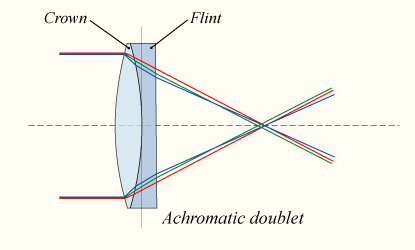Chromatic aberration
|
|
Chromatic aberration is caused by the dispersion of the lens material, the variation of its refractive index n with the wavelength of light.
Since the focal length f of a lens is dependent on n, different wavelengths of light will be focused on different positions. Chromatic aberration of a lens is seen as "fringes" of color around the image, because each color in the optical spectrum cannot be focused at a single common point on the optical axis. However, there exists a point called the circle of least confusion, where this effect can be minimized.
Chromatic aberration can be further minimized by using an achromatic doublet or achromat in which two materials with differing dispersion are bonded together to form a single lens. This reduces the amount of chromatic aberration over a certain range of wavelengths, though it does not produce perfect correction. By combining more than two lenses of different chemical composition, the amount of correction can be further increased, as seen in an apochromatic lens or apochromat.
Many types of glass have been developed to reduce chromatic aberration, most notably, glasses containing fluorite. These hybridized glasses have a very low level of optical dispersion; only two compiled lenses made of these substances can yield a high level of correction.
The use of achromats was an important step in the development of the optical microscope.
See also
External link
- Explanation of chromatic aberration by Paul van Walree (http://www.vanwalree.com/optics/chromatic.html)de:Chromatische Aberration
fr:Aberration chromatique it:Aberrazione cromatica nl:Chromatische aberratie pl:Aberracja chromatyczna ru:Хроматическая аберрация sv:Kromatisk aberration


